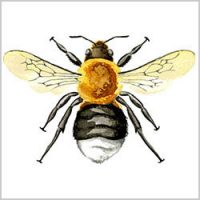Tree Bumblebee
Bombus hypnorum
A relatively recent arrival to the UK from mainland Europe. First recorded in Wiltshire in 2001, the Tree Bumblebee is now one of our most common bumblebees, reaching Scotland in 2013. Its success may be partly due to its ability to exploit nest sites that other bees do not use.
Appearance
This bumblebee has distinct markings that set it apart from most other species.
Queens, workers and males all have a ginger-brown thorax and a black abdomen with a white tail. Some queens and workers have a darker, or even black thorax, but always retain their white tail.
Males have brown facial hairs and one or two ginger-brown bands at the base of the abdomen.

About the bee
– white tail
– black abdomen
– ginger-brown thorax
Size
– Queen: 15mm
– Worker: 11mm
– Male: 13mm
Tongue length
– Short
Nest
Almost always above ground, in locations such as roof eaves and unused bird boxes. Groups of males can be seen flying around nest sites, waiting for new queens to emerge.
Colony size
Medium (around 150 workers)
Map and flight periods

Similar species
The Common Carder Bee may resemble the Tree Bumblebee as they have the same ginger-brown thorax and the abdomen can appear very dark, but they never have a white tail.


